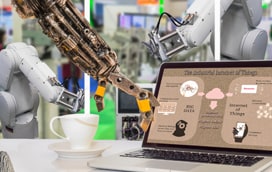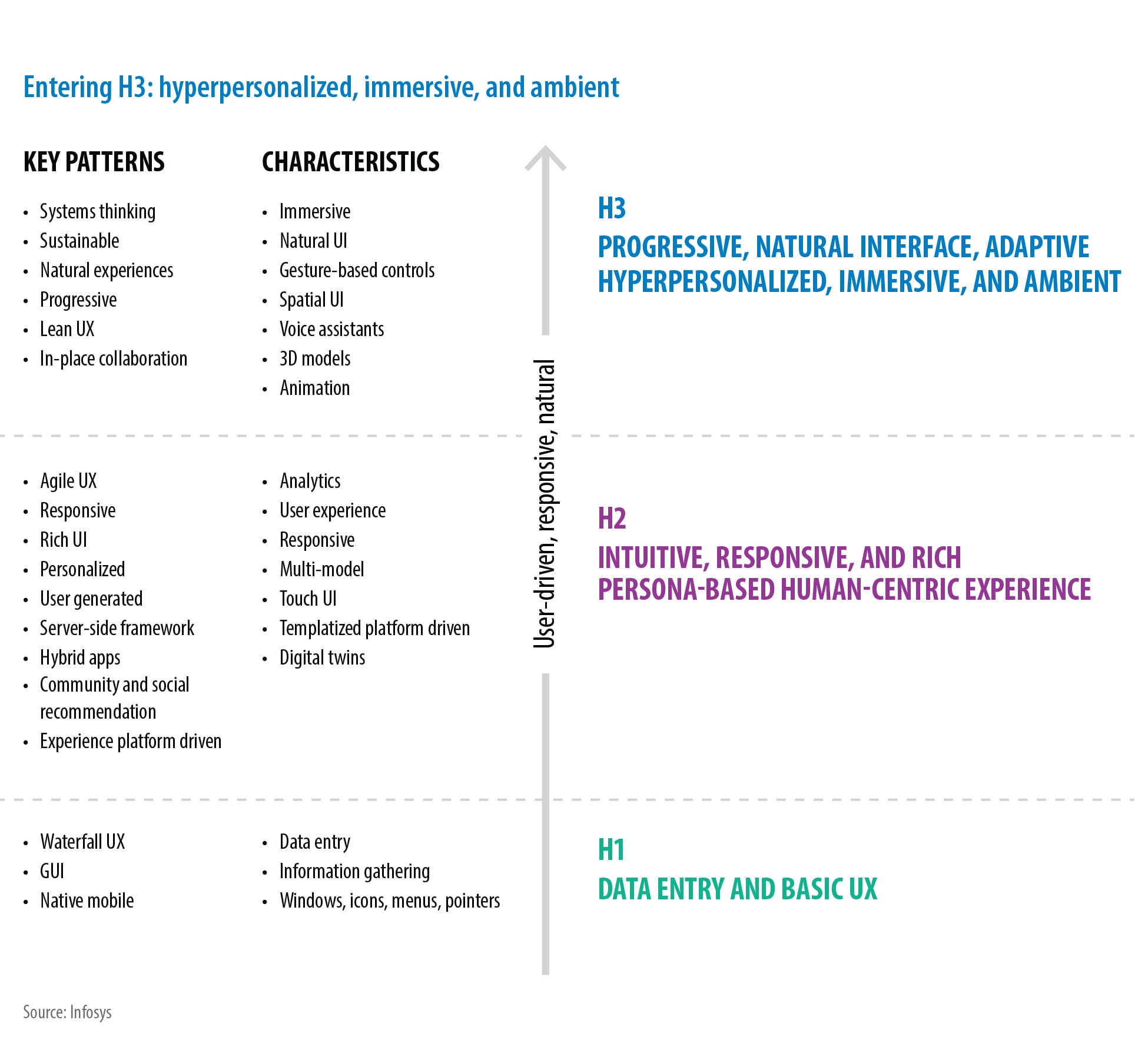Experience
Users want intelligent, immersive, and meaningful experiences. Organizations should fulfill the latest asks for hyperpersonalization and touchless interactions. That too with security and transparency. Experience design can help deliver such effectual experiences by combining physical, digital, social, and environmental elements. Developments across artificial intelligence (AI), edge computing, and extended reality (XR) have much to offer.
The road to natural, progressive and adaptive interfaces
H3
Progressive, natural interface, adaptive hyperpersonalized, immersive, and ambient
Key Patterns
- System thinking
- Sustainable
- Natural experiences
- Progressive
- Lean UX
- In-place collaboration
Characteristics
- Immersive
- Natural UI
- Gesture-based controls
- Spatial UI
- Voice assistants
- 3D models
- Animation
H2
Intuitive, responsive, and rich persona-based human-centric experience
Key Patterns
- Agile UX
- Responsive
- Rich UI
- Personalized
- User generated
- Server-side framework
- Hybrid apps
- Community and social recommendation
- Experience platform driven
Characteristics
- Analytics
- User experience
- Responsive
- Multi-model
- Touch UI
- Templatized platform driven
- Digital twins
H1
Data entry and basic UX
Key Patterns
- Waterfall UX
- GUI
- Native mobile
Characteristics
- Data entry
- Information gathering
- Windows, icons, menus, pointer
Key trends across experience subdomains
Trend 1
Designers become more integral and versatile to enhance UX
As next-generation technologies integrate more with services, processes, and experiences, the role of designers becomes integral and versatile. Designers reinvent the business value of design by enhancing physical, digital, and social usage, while ensuring environmental sustainability
Trend 2
Safe and secure designs become prominent to win customer trust
Digital data drives businesses, but the major differentiator is the safety and security of that data. Now, organizations are focusing on collecting only essential data and avoiding the risk exposure of securing and storing large data pools.Beyond data provenance, governance, and compliance, products must win over consumers by demonstrating how exactly consumers' data is being used.
Trend 3
Contactless experiences gain consideration across industries
Business-to-business (B2B) and business-to-consumer (B2C) interactions are increasingly becoming contactless — meetings, transactions, purchases, credit cards, consultations, curbside pickup, etc. The reason is convenience and heightened awareness of health and safety. Technologies such as AI, 5G, and cloud platforms enhance contactless experiences.
Trend 4
Collaborative design brings cross-functional teams together
Metaverse is altering how people perceive their jobs, social interactions, ecommerce dealings, etc. To enable this transformation, collaborative design is gaining momentum globally. Large tech companies such as Adobe, Microsoft, and Figma are developing collaborative designing platforms to build metaverse assets.
Trend 5
LCNC to democratize metaverse designing
LCNC designs require minimal to no coding knowledge. They even allow end users to participate in the development process. With the participation from these citizen coders, the collective imagination and creativity pool is much wider. This helps in building robust software pipelines, democratizes tech-focused innovation, and, in turn, builds business' IP.
Trend 6
Gesture-controlled UIs find usage across businesses
The next generation of UI is about touch-free control, which enables communication through speech, gestures, and facial expressions. Touch-free controls are especially relevant in today's health-conscious world and promise a whole new level of engagement.
Trend 7
Rapid naturalization of human-machine interaction improves UX
Natural UIs represent simplified human-machine interactions. These smarter interfaces arose with the advent of social channels and progressed as social media became the primary source of engagement for both business and leisure.
Trend 8
Conversational channels become more immersive and personalized
A large part of the world has already experienced chatbot interactions and voice AI such as Amazon's Alexa. These communication platforms blend natural language processing (NLP) and AI to create humanlike interactions. But they respond to every user the same way and lack personalization.
Trend 9
Immersive experiences are increasingly turning humanlike
Immersive experiences are a step closer to near-humanlike interactions, as they help bridge the gap between the physical and digital worlds and present a multidimensional, multimodal experience. But this technology is expensive and only now gaining a foothold in the business world.
Trend 10
JavaScript in the frontend technology landscape continues to dominate
JavaScript has been popular as a programming language. Its capabilities such as native support on browsers and the ability to run on many devices make it a compelling choice for developers to reach a wide audience.
Trend 11
Spatial UIs with real-time inputs enhance UX
AI, VR, and MR UXs rely on real-time inputs from the physical world to deliver outputs. These are a blend of real-world data and programmed elements that make them suitable for this phygital environment.
Trend 12
SAP's LCNC tools encourage citizen developers
SAP AG is a leader in enabling citizen developers with LCNC tools and platforms to build enterprise-grade applications. It provides streamlined UXs for any business domain.
Trend 13
Increased adoption of circular solutions for a better planet
Circular designs push sustainability to the forefront, becoming an intrinsic component of the design system. Instead of simply seeking LEED certification for a single building, circular designs tackle supply chain, product life cycle management, manufacturing, and even post-consumer use scenarios, maximizing the system's efficiency.
Trend 14
Metrics as a design feature help achieve circularity and sustainability
Businesses are increasingly embedding “metrics as a design” feature to measure the environmental costs of products. It looks at carbon footprint data and metrics such as waste data, water footprint data, and virtual water data to bring strategic insights and enhance sustainable manufacturing for a circular economy.
Trend 15
Product designs change as right to repair (RTR) gains momentum
RTR is transforming from a consumer ask to a regulatory requirement in several countries. It allows users, consumers, and businesses to repair their devices on their own without any legal or technical restrictions. The U.K. and a few U.S. states already allow varying RTR levels.
Trend 16
Experience- and intelligence-driven commerce provides superior customer engagement
E-commerce activity has surged in recent years to become a critical driver of platform modernization. As consumers become more selective about their purchases, brands are investing in sophisticated commerce platforms that focus on the entire customer journey to provide better experiences and derive meaningful insights.
Trend 17
AI-driven, next-generation, hyperpersonalized UXs gain prominence
Content personalization in websites and mobile applications was mostly driven by rules defined in content management systems, experience management solutions, and analytics engines. These rules relied on frontend user interactions or a history of user patterns captured at the backend.
Trend 18
Enhanced content localization with AI
Large global enterprises are increasingly looking at AI-powered, real-time translators to fulfill their localization needs. Language translation technologies are enabling organizations to shift from large, distributed help desks to a centralized help desk model using AI-powered translators to respond to end users in the languages of their choice.
Trend 19
Accessibility advancements help onboard new users
Accessibility tools allow people with disabilities to use devices and the web smoothly. These tools have gained much prominence and are a regulatory requirement in some parts of the world. According to the World Health Organization (WHO), about 15% of the world's population has some form of disability, indicating the necessity.
Trend 20
Privacy protection becomes critical and central to futuristic designs
Enterprises handle massive amounts of data in a highly interconnected world. The downside of having abundant data is potential breaches. Reports of data theft or data used for fraudulent purposes are on the rise, as cyberattacks become more sophisticated.
What's New
Latest White Papers, Tech Blogs and View Points

Subscribe
To keep yourself updated on the latest technology and industry trends subscribe to the Infosys Knowledge Institute's publications
Count me in!



















